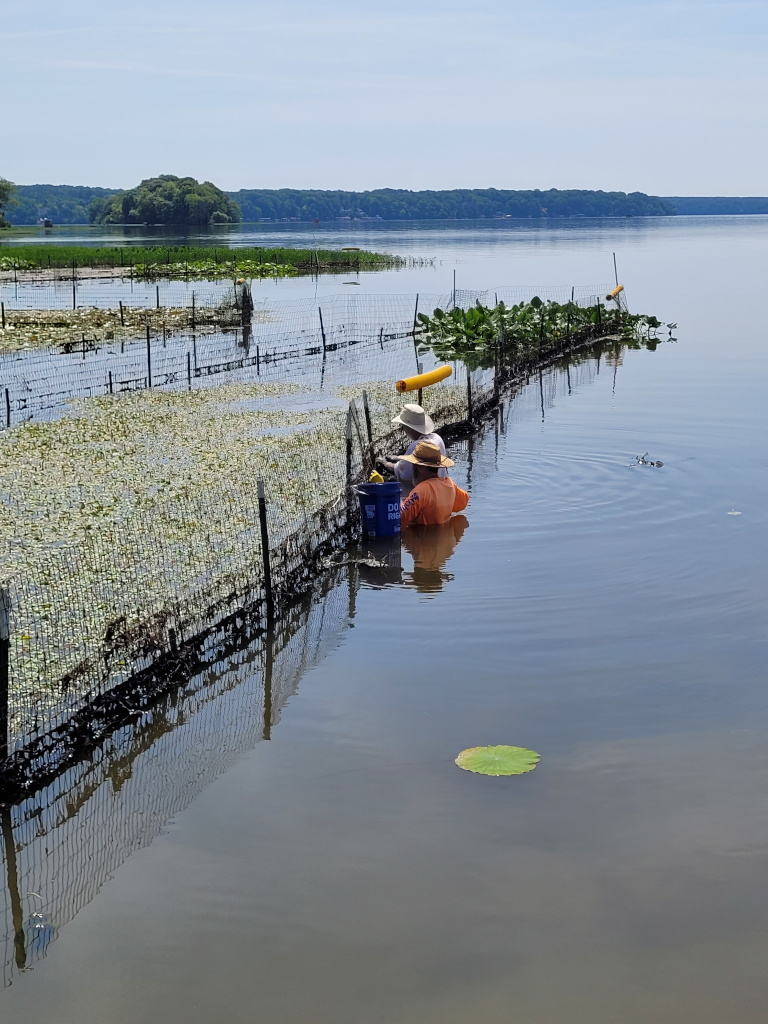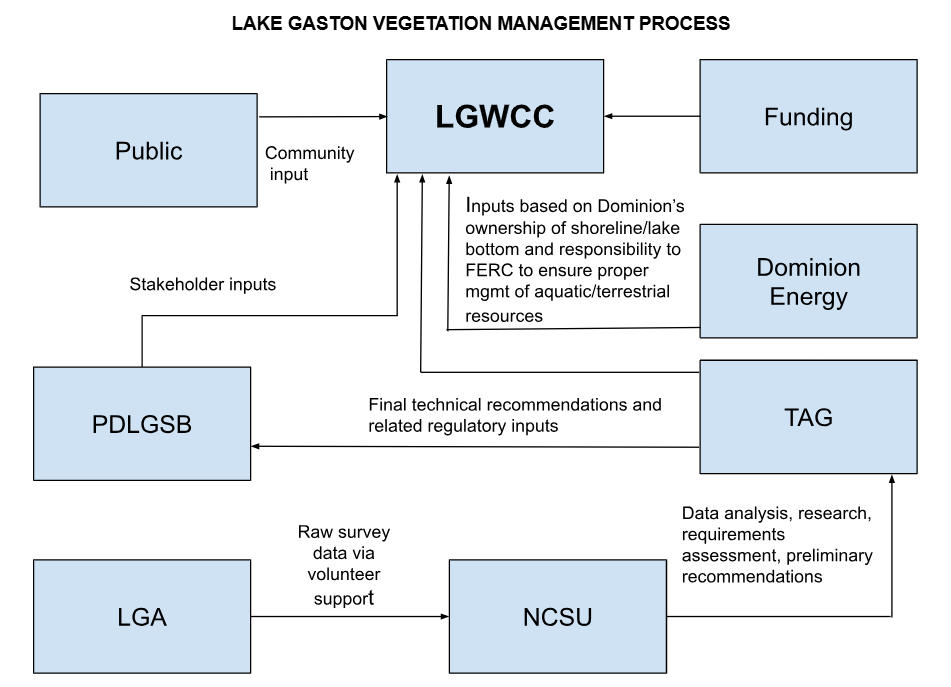
Aquatic Vegetation Management
Overview of Management Process
How to Report an Aquatic Weed Issue to the LGWCC and NCSU
Overview of Management Process
Managing Aquatic Vegetation on Lake Gaston
Controlling invasive/noxious aquatic vegetation while enhancing native vegetation on Lake Gaston involves numerous agencies and organizations cooperating in an integrated management effort. These “partners” are at the forefront of helping to ensure Lake Gaston water quality for residents and visitors enjoyment. The quality of life around the lake as well as property values are enhanced when the lake environment can support swimming, boating, fishing, wildlife management and other activities. Efforts to manage aquatic vegetation on the lake are an ongoing process that involves annual planning, analysis, and project execution each year. A critical element to all this work is obtaining annual funding from Virginia, North
Carolina, Brunswick County, Mecklenburg County,
Halifax County, Northampton County, Warren County and Virginia Beach. Without annual funding from these jurisdictions the necessary work cannot be accomplished. Key stakeholders in the management of aquatic vegetation on Lake Gaston include:

Lake Gaston Weed Control Council (LGWCC) is the primary governing body that oversees the programs to manage aquatic vegetation including the control of invasive/noxious vegetation and enhancement of native vegetation on the lake. There are three appointed members on the Council from each of the five lake counties identified above. The Council has been leading the lake vegetation management efforts since 1985. The Council makes decisions and determines how funding is spent to achieve the desired outcomes.
The Technical Advisory Group (TAG) provides the LGWCC with technical data and recommendations based on science to ensure the best information is used when making determinations on how to execute the programs and supporting projects designed to maintain and improve lake water quality and associated aquatic vegetation. Experts from NC and VA wildlife and environmental management agencies along with NC State University, US Army Corps of Engineers, Dominion Energy, and others are part of the TAG.
Pete Deschenes Stakeholders Board (PDSB) is composed of various organizations that have an interest in ensuring aquatic vegetation is managed and water quality is maintained on Lake Gaston. The Board works closely with the LGWCC, TAG and the LGA to ensure that the best interests of the lake environment, including fisheries and wildlife, are part of the vegetation management processes. The Board includes local, regional, state, and federal membership to provide a broad perspective to its deliberations and recommendations.

The Lake Gaston Association (LGA) has a critical role in the aquatic vegetation management programs and supporting projects. The LGA, primarily via the Environment Committee, provides volunteer labor to conduct the annual lake vegetation survey which forms the basis for management decisions related to invasive/noxious vegetation treatment actions. The LGA volunteers are also the primary labor force behind the annual efforts to enhance native vegetation habitat. In addition, the LGA helps ensure that its membership and other lake residents are aware of plans and proposed actions related to management of aquatic vegetation on Lake Gaston.
North Carolina State University (NCSU) provides fisheries and aquatic vegetation program management and technical expertise, including field work, in support of Lake Gaston aquatic vegetation management. Much of the work done by NCSU is via contracts awarded by
the LGWCC to conduct studies and prepare reports to help guide the process of aquatic vegetation management control and habitat enhancement for Lake Gaston.
An example of a major success story of controlling invasive vegetation on Lake Gaston involves hydrilla. Most lake residents recall a time when trying to boat or swim in the lake was an unpleasant experience due to the proliferation of hydrilla vegetation. Hydrilla, a non-native aquatic plant, has been known to be present in Lake Gaston since the 1980’s. Thousands of acres of the lake were infested with the “weed.” The control of hydrilla has been ongoing for over 30 years using a combination of stocking sterile grass carp that feed on the plant and the strategic application of chemical herbicides in selected areas based on TAG recommendations to the LGWCC. The process of using grass carp and chemicals to treat hydrilla is a delicate balance to control the “weed,” while minimizing the negative impacts to native vegetation and wildlife in the lake. Today, in 2024, hydrilla is under control on Lake Gaston. It is not eradicated and probably never will be, due to its ability to remain viable as tubers rooted in the lake floor for many years. Hydrilla is still present in the upper reaches of many creeks and streams that feed into Lake Gaston and is one reason we must continue to survey, monitor, and actively treat for hydrilla when conditions indicate the need.
A new aquatic vegetation “enemy” is currently being fought in the waters of Lake Gaston – lyngbya. Lyngbya, technically a cyanobacteria, is a blue green alga that forms black mats either below (winter/spring) or on the water surface (summer/fall) depending on the season. It is a nasty character that has been known to be present in Lake Gaston since the mid-1990’s. In recent years, lyngbya has expanded in areas around the lake for reasons not yet fully understood. The stakeholders, via a LGWCC contract with NCSU, are currently studying and actively working to treat and control lyngbya. Much of the work accomplished and underway is leading edge science as there is not a lot of available information or experience in effectively dealing with lyngbya.
Organizational Relationships and Process Diagram

How to Identify and Report an Aquatic Weed Issue to the LGWCC and NCSU
To identify your aquatic vegetation, click on this link: Lake Gaston Aquatic Vegetation ID Booklet
To report aquatic plant issues on Lake Gaston, please fill in the following form:
https://forms.gle/HDETJHXqjLKuArj66
Contact the NCSU Lake Gaston Extension Associate:
aquaticplants@ncsu.edu
2025 Update on LKG Aquatic Vegetation
Annual Vegetation Survey Results (current)
NCSU LGWCC March 11, 2025 Presentation
2024 Lake Gaston Vegetation Survey Report